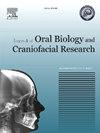An in-vitro exploration of the antifibrotic activity of Naringenin: A potential therapeutic agent for oral submucous fibrosis management
Q1 Medicine
Journal of oral biology and craniofacial research
Pub Date : 2025-06-12
DOI:10.1016/j.jobcr.2025.06.006
引用次数: 0
Abstract
Background
Oral submucous fibrosis (OSMF) is a precancerous condition primarily associated with betel nut chewing. Naringenin, a flavonoid found in citrus fruits, has been demonstrated to show antifibrotic effects in various fibrosis models. The present study was conducted to investigate the potential antifibrotic properties of naringenin in Human gingival fibroblasts (HGFs) exposed to arecoline.
Materials and methods
Naringenin was extracted from grapefruit peel using methanol and characterized via Gas Chromatography-Mass Spectrometry (GC-MS). HGFs were cultured in Dulbecco's Modified Eagle Medium and treated with arecoline to induce fibrosis. The cells were then exposed to naringenin at varying concentrations. Cytotoxicity was assessed using the MTT assay, while the expression of fibrotic markers was quantified using real-time polymerase chain reaction (PCR). Additionally, Masson's trichrome staining was performed to evaluate the collagen deposition aided by An in-silico pharmacological network analysis.
Results
GC-MS confirmed the presence of naringenin as a major bioactive compound in grapefruit peel extract. Naringenin significantly improved cell viability in arecoline-treated HGFs. It was found that naringenin markedly downregulated the expression of fibrotic markers, as compared to the arecoline-only group. Histopathological analysis demonstrated a reduction in collagen deposition following naringenin treatment. Pharmacological network analysis identified potential pathways targeted by naringenin, including TGF-β, PI3K-Akt, and MAPK signaling, with hub genes such as MMP9 and TGFB1 playing central roles.
Conclusion
Naringenin exhibits promising antifibrotic activity in arecoline-induced fibrosis in HGFs, potentially through modulation of key fibrotic signaling pathways. These findings highlight its potential role as a therapeutic agent for OSMF management.
柚皮素抗纤维化活性的体外研究:一种治疗口腔黏膜下纤维化的潜在药物
背景:口腔黏膜下纤维化(OSMF)是一种主要与咀嚼槟榔有关的癌前病变。柚皮素是一种在柑橘类水果中发现的类黄酮,已被证明在各种纤维化模型中具有抗纤维化作用。本研究旨在探讨柚皮素对槟榔碱暴露的人牙龈成纤维细胞(HGFs)的潜在抗纤维化作用。材料与方法以柚子皮为原料,甲醇提取柚皮中的蛇毒素,采用气相色谱-质谱联用(GC-MS)对其进行表征。hgf在Dulbecco's Modified Eagle培养基中培养,槟榔碱处理诱导纤维化。然后将细胞暴露在不同浓度的柚皮素中。使用MTT法评估细胞毒性,同时使用实时聚合酶链反应(PCR)定量纤维化标志物的表达。此外,采用马松三色染色法评估胶原沉积,并辅以计算机药理网络分析。结果gc - ms证实柚皮提取物中柚皮素是主要的生物活性物质。柚皮素显著提高槟榔碱处理的hgf细胞活力。结果发现,与仅槟榔碱组相比,柚皮素显著下调了纤维化标志物的表达。组织病理学分析显示柚皮素治疗后胶原沉积减少。药理网络分析确定了柚皮素的潜在靶点,包括TGF-β、PI3K-Akt和MAPK信号通路,其中枢纽基因如MMP9和TGFB1发挥核心作用。结论柚皮素在槟榔碱诱导的hgf纤维化中表现出良好的抗纤维化活性,可能通过调节关键的纤维化信号通路。这些发现突出了其作为OSMF治疗药物的潜在作用。
本文章由计算机程序翻译,如有差异,请以英文原文为准。
求助全文
约1分钟内获得全文
求助全文
来源期刊

Journal of oral biology and craniofacial research
Medicine-Otorhinolaryngology
CiteScore
4.90
自引率
0.00%
发文量
133
审稿时长
167 days
期刊介绍:
Journal of Oral Biology and Craniofacial Research (JOBCR)is the official journal of the Craniofacial Research Foundation (CRF). The journal aims to provide a common platform for both clinical and translational research and to promote interdisciplinary sciences in craniofacial region. JOBCR publishes content that includes diseases, injuries and defects in the head, neck, face, jaws and the hard and soft tissues of the mouth and jaws and face region; diagnosis and medical management of diseases specific to the orofacial tissues and of oral manifestations of systemic diseases; studies on identifying populations at risk of oral disease or in need of specific care, and comparing regional, environmental, social, and access similarities and differences in dental care between populations; diseases of the mouth and related structures like salivary glands, temporomandibular joints, facial muscles and perioral skin; biomedical engineering, tissue engineering and stem cells. The journal publishes reviews, commentaries, peer-reviewed original research articles, short communication, and case reports.
 求助内容:
求助内容: 应助结果提醒方式:
应助结果提醒方式:


